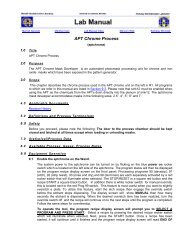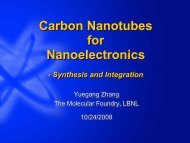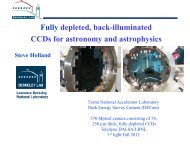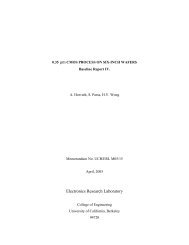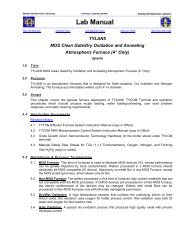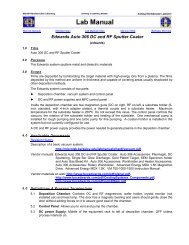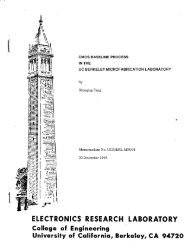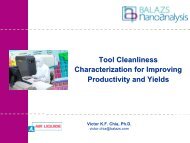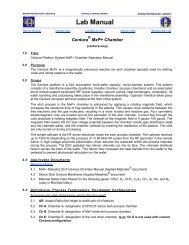The Furture of Semiconductor Industry from ... - Berkeley Microlab
The Furture of Semiconductor Industry from ... - Berkeley Microlab
The Furture of Semiconductor Industry from ... - Berkeley Microlab
Create successful ePaper yourself
Turn your PDF publications into a flip-book with our unique Google optimized e-Paper software.
<strong>The</strong> Future <strong>of</strong> <strong>Semiconductor</strong> <strong>Industry</strong> <strong>from</strong><br />
“Fabless” Perspective<br />
Roawen Chen, Ph.D.<br />
GM and VP <strong>of</strong> Connectivity Business Unit<br />
& VP <strong>of</strong> Manufacturing Operations<br />
Marvell <strong>Semiconductor</strong><br />
UC <strong>Berkeley</strong> Solid-State Seminar<br />
Feb. 1 st , 2008<br />
Marvell Confidential © 2007
Outline<br />
Introduction<br />
Fabless Business Model Adoption<br />
Foundry Technology and <strong>Industry</strong> Trend<br />
Observation <strong>of</strong> the Future <strong>of</strong> <strong>Semiconductor</strong> industry<br />
2<br />
Marvell Confidential © 2007
<strong>Semiconductor</strong> Business Models<br />
Fabless<br />
Fab-Lite<br />
IDM<br />
Marketing/Sales<br />
Marketing/Sales<br />
Marketing/Sales<br />
Design/IP<br />
Design/IP<br />
Design/IP<br />
Manufacturing<br />
Foundry<br />
partners<br />
Manufacturing<br />
Foundry<br />
partners<br />
Internal<br />
Manuf<br />
Manufacturing<br />
Marvell, Nvidia<br />
TI, Infineon<br />
Intel, Samsung<br />
<strong>Semiconductor</strong> manufacturing models are migrating to asset-light<br />
strategy<br />
3<br />
Marvell Confidential © 2007
Soaring Cost <strong>of</strong> Chip Making<br />
$6.0<br />
Data source: UMC<br />
$5.0<br />
$5.0<br />
$4.3<br />
$3.6<br />
$4.0<br />
$3.0<br />
$3.0<br />
$1.8<br />
$2.0<br />
Fab Cost ($B)<br />
$1.3<br />
$0.7<br />
$1.0<br />
$0.2 $0.3 $0.4<br />
$0.0<br />
1983 1987 1990 1994 1997 1999 2001 2003 2005 2007<br />
Year<br />
<strong>The</strong> cost <strong>of</strong> being IDM is increasing with each new tech node<br />
advancement, resulting in a outsourcing phenomenon<br />
4<br />
Marvell Confidential © 2007
Fab is simply unaffordable by IDM model<br />
2007 Top 20 <strong>Semiconductor</strong> Companies by Revenue<br />
40<br />
35<br />
$7B revenue<br />
required to support<br />
300mm Fab<br />
30<br />
25<br />
20<br />
($B)<br />
15<br />
10<br />
5<br />
0<br />
Sharp<br />
Broadcom<br />
Elpida<br />
Matsushita<br />
Qimonda<br />
Micron<br />
Freescale<br />
NEC<br />
Qualcomm<br />
AMD<br />
Infineon<br />
NXP<br />
Sony<br />
Renesas<br />
Hynix<br />
STMicro<br />
TI<br />
Toshiba<br />
Samsung<br />
Intel<br />
Data source: Goldman Sachs<br />
5<br />
Marvell Confidential © 2007
Why Fabless Business Model Attractive?<br />
Demand<br />
Cycles<br />
Fab-Lite Utilization companies Shortage <strong>of</strong><br />
IDM Fab-Lite capacity complement keeps worsens internal supply capacity during<br />
built internal follows constraints capacity during with the foundries, boom time!<br />
the 100% demand loaded, down but…time,<br />
but… while… and…<br />
How to dispose<br />
excess capacities<br />
when technology<br />
moves on ?<br />
Demand<br />
Flexible Fabless Model will Prevail !!!<br />
Flexible Fabless Model will Prevail !!!<br />
Excess Capicities In House Capacity<br />
Y2010<br />
Y2000<br />
6<br />
Marvell Confidential © 2007
Fabless <strong>Semiconductor</strong> Growth<br />
60<br />
300<br />
50<br />
Fabless ~20%<br />
<strong>of</strong> overall<br />
Semi<br />
overall semiconductor<br />
250<br />
fabless<br />
Fabless Sales ($B)<br />
40<br />
Marvell<br />
founded<br />
200<br />
30<br />
TSMC<br />
founded<br />
150<br />
20<br />
100<br />
10<br />
50<br />
Overall <strong>Semiconductor</strong> Sales ($B)<br />
0<br />
0<br />
2006<br />
2005<br />
2004<br />
2003<br />
2002<br />
2001<br />
2000<br />
1999<br />
1998<br />
1997<br />
1996<br />
1995<br />
1994<br />
1993<br />
1992<br />
1991<br />
1990<br />
1989<br />
1988<br />
1987<br />
Data source: EE Times<br />
7<br />
Marvell Confidential © 2007
Real Men Started to Rent Fabs<br />
Intel<br />
Memory<br />
Fab-lite<br />
Fabless<br />
Q1 '07 Q2 '07<br />
Q1-07 Q2-07<br />
Company Name<br />
% <strong>of</strong> Total<br />
Rank Rank<br />
Rvenue($M) Rvenue($M)<br />
1 1 Intel 7,868 7,728 12.25%<br />
2 2 Samsung Electronics 4,835 4,716 7.48%<br />
4 3 Texas Instruments 2,900 3,030 4.80%<br />
3 4 Toshiba 3,109 2,510 3.98%<br />
6 5 STMicroelectronics 2,276 2,418 3.83%<br />
8 6 Renesas Technology 1,948 1,985 3.15%<br />
5 7 Hynix 2,539 1,963 3.11%<br />
9 8 NXP 1,427 1,472 2.33%<br />
14 9 Qualcomm 1,259 1,367 2.17%<br />
13 10 Infineon Technologies 1,282 1,363 2.16%<br />
All Others 35,975 34,519 54.73%<br />
Total <strong>Semiconductor</strong> 65,418 63,071 100%<br />
Data source: FSA<br />
Fabless company, for the first time, enters<br />
<strong>Semiconductor</strong> Top-10 (Q2 2007)<br />
8<br />
Marvell Confidential © 2007
Fabless Companies: No longer small players<br />
10000<br />
9000<br />
1998 Revenue<br />
8000<br />
2007 Revenue<br />
7000<br />
6000<br />
5000<br />
4000<br />
3000<br />
Revenue($M)<br />
2000<br />
1000<br />
0<br />
S3<br />
ESS<br />
Level One<br />
Compaq<br />
Sun Micro<br />
ATI<br />
Cirrus Logic<br />
Altera<br />
Avago<br />
Xilinx<br />
LSI<br />
Media Tek<br />
Marvell<br />
Broadcom<br />
Nvidia<br />
SanDisk<br />
Qualcomm<br />
Fabless-ers<br />
Data source: FSA<br />
In 1998, top 3 fabless companies (Altera, Qualcomm and Xilinx)<br />
each had ~$500M annual revenue; Today in 2008, more than 10<br />
fabless companies have each surpassed $1B in annual revenue<br />
9<br />
Marvell Confidential © 2007
Fabless revenue is merely ~20% <strong>of</strong> Worldwide IC$, Potential<br />
Growth is Huge<br />
Automotive<br />
6.4%<br />
uP/uCP<br />
16.0%<br />
IDM Stronghold<br />
Industrial<br />
Electronics<br />
8.6%<br />
IDM dominated<br />
Fabless Stronghold<br />
Memory<br />
17.3%<br />
Consumer<br />
Electronics<br />
19.5%<br />
Storage/Printer<br />
4.3%<br />
2007<br />
$260 Billion<br />
Grapc/FPGA<br />
3.0%<br />
Wireless<br />
Communications<br />
19.1%<br />
Data source: iSuppli<br />
Wired<br />
Communications<br />
6.0%<br />
Fabless company grows <strong>from</strong> traditional trench, it is inevitable to<br />
invade into IDM pie. Wireless and Consumer electronics are two<br />
likely areas<br />
10<br />
Marvell Confidential © 2007
Process Technology is no longer Differentiator ….<br />
Si SiTechnology Technology itself no no<br />
longer a key<br />
differentiator for for IDM’s<br />
0.7<br />
ITRS Roadmap<br />
0.6<br />
Technology Technology is is more<br />
standardized<br />
Foundry<br />
0.5<br />
0.4<br />
Foundry Foundry technology is is<br />
the de-factor process<br />
choice today for for most <strong>of</strong> <strong>of</strong><br />
semiconductor<br />
companies<br />
0.3<br />
Linewidth (um)<br />
0.2<br />
0.1<br />
0<br />
1994 1996 1998 2000 2002 2004 2006<br />
Foundry Foundry process<br />
technology is is the<br />
leading-edge.<br />
Year<br />
Data source: Gartner<br />
Foundry is is well in in pace with<br />
industry technology roadmap<br />
11<br />
Marvell Confidential © 2007
Foundry Technology in Par with <strong>Industry</strong> Leader<br />
TSMC and Intel featured 2007<br />
IEDM with 2 most significant<br />
papers<br />
TSMC<br />
Traditional SiO2 Gate Oxide w/<br />
Nitridation<br />
Immersion Litho (193nm w/ 1.35<br />
Max NA)<br />
Ultra Low-K (K=2.55)<br />
Intel<br />
High-K Metal Gate (dual WF gate<br />
metal)<br />
Dry Litho (193nm w/ 0.92 NA)<br />
Foundry process choice is<br />
more cost-effective and<br />
diversified<br />
12<br />
Marvell Confidential © 2007
32nm and beyond?<br />
Performance/<br />
Power<br />
Velocity saturation, Mobility degradation,<br />
Vdd scalability, Variations; Physics<br />
Wafer Price<br />
(8” equivalent)<br />
1.25 - 1.35x<br />
each new node<br />
Technology Node<br />
Technology Node<br />
0.25µm 0.18µm 0.13µm 90nm 65nm 45nm<br />
0.25µm 0.18µm 0.13µm 90nm 65nm 45nm<br />
ASP <strong>of</strong> Consumer IC’s<br />
High-k Metal Gate<br />
immersion<br />
Wafer Cost<br />
(8” equivalent)<br />
Cu/Low-k<br />
Consumers/B2B expect 2x reduction<br />
in cost per function each node<br />
Technology Node<br />
Technology Node<br />
0.25µm 0.18µm 0.13µm 90nm 65nm 45nm<br />
0.25µm 0.18µm 0.13µm 90nm 65nm 45nm<br />
13<br />
With all these boundary conditions, ROI beyond 32nm<br />
may be questionable<br />
Marvell Confidential © 2007
Future Trends <strong>of</strong> <strong>Semiconductor</strong> <strong>Industry</strong><br />
Three types <strong>of</strong> <strong>Semiconductor</strong> players in the future<br />
Intel<br />
Memory<br />
Fabless/Foundry<br />
TSMC dominance, standardization <strong>of</strong> CMOS process <strong>of</strong>fers<br />
“Device scaling” diminishing and “dimension scaling” slow if not stop<br />
Consolidation is inevitable, big becomes bigger, economic scales win<br />
Innovation and collaboration are our hopes for future success <strong>of</strong> IC –<br />
innovations never die. Some potential topics are<br />
Non-CMOS technologies at mature process node. E.g., Ultra-HV power<br />
device (energy efficient), MEMS….etc.<br />
How to reduce high mask cost (critical for innovative designs to fly)<br />
Breakthrough in nano-devices compatible with current CMOS Si<br />
infrastructure<br />
Top research in mechanical/thermal aspects <strong>of</strong> packaging<br />
Design for Manufacturing (DFM) a must for 45nm and beyond<br />
14<br />
Marvell Confidential © 2007
Summary<br />
Fab costs sharply increase during the last decade, technology<br />
brings only incremental benefit which may not justify the high<br />
financial risk <strong>of</strong> owning fab. Process Technology becomes<br />
standardized.<br />
Analysis <strong>of</strong> the fabless/foundry business model illustrates that it is<br />
the preferred model for companies to excel in the semiconductor<br />
industry, with the highest flexibility to address dynamic markets<br />
IDM’s are transitioning into fablite or fabless somewhere in between<br />
65nm and 32nm<br />
As fabless becomes mainstream, paradigm shift demands<br />
innovation and collaboration among supply-chains, to further lower<br />
the cost <strong>of</strong> IC’s and accelerate the growth <strong>of</strong> semiconductor<br />
industry<br />
15<br />
Marvell Confidential © 2007
Paradigm Shift<br />
“Only Only Real Men have Fabs” Fabs<br />
Jerry Sanders III, CEO <strong>of</strong> AMD, circa. 1991<br />
Jerry Sanders III, CEO <strong>of</strong> AMD, circa. 1991<br />
“Only Only Real Men Go Fabless”<br />
Fabless<br />
16<br />
Marvell Confidential © 2007
Thank You<br />
Marvell Confidential © 2007


